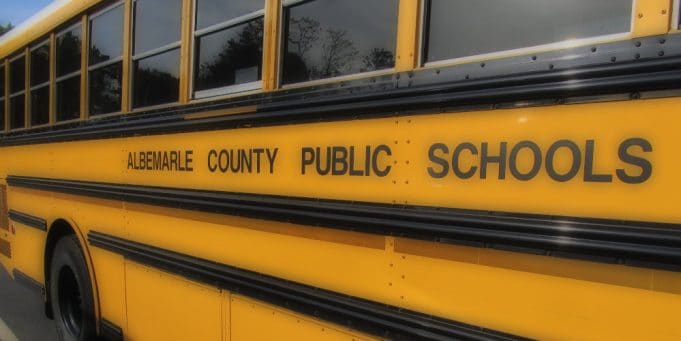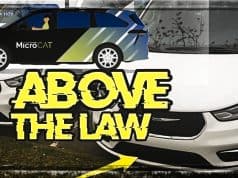by: Publius
 Albemarle County and Charlottesville’s seemingly never-ending deficit of school bus drivers is caused by the same issues that impact driver recruitment in most of the nation. The problem is not a lack of supply of drivers but rather a bureaucratic juggernaut that requires drivers to assume a tremendous amount of RESPONSIBILITY while providing them with little effective AUTHORITY. The Chicom Virus of 2020 was simply the precursor that illuminated this longstanding difficulty in the school pupil transportation industry.
Albemarle County and Charlottesville’s seemingly never-ending deficit of school bus drivers is caused by the same issues that impact driver recruitment in most of the nation. The problem is not a lack of supply of drivers but rather a bureaucratic juggernaut that requires drivers to assume a tremendous amount of RESPONSIBILITY while providing them with little effective AUTHORITY. The Chicom Virus of 2020 was simply the precursor that illuminated this longstanding difficulty in the school pupil transportation industry.
As difficult as it is to believe, less than a half a century ago, junior and senior high school students were not only able, but encouraged, to serve as school bus operators. I had considered it myself, but chose the freedom of driving my own vehicle those final two years. Students took their busses home each day and were responsible for their cleanliness and upkeep. Today, it would be unimaginable to remotely consider allowing a sixteen or seventeen year old student that amount of responsibility.
With the advent of the Commercial Drivers License (CDL) licensing structure put into place in the early 90s the option of using teens as school bus drivers was permanently eliminated. Operators now must receive numerous hours of classroom instruction followed by forty hours supervised behind-the-wheel instruction. Operators are strictly supervised, regularly reviewed, and the best efforts are enacted to make sure that students are being transported in a professional and safe manner to and from school each day. All buses must meet federal and state criteria for survivability in accidents.
So, what is the actual issue behind the operator shortage?
The issue is not one of mechanics or infrastructure. That has a self-evident documentable history of success. The issue lies with the manner in which those operators are forced to comport themselves with the students. Imagine if you will, daily driving through the community on all kinds of roads in a forty-five foot vehicle with a weight average between 20,000 to 38,000 pounds depending on the amount of fuel and passengers on board. Most times, you have two fifty-gallon tanks of diesel, one on each side, or a single one-hundred -gallon tank, from which you’re getting roughly four to six miles per gallon. It sounds daunting because it is. Factor into that equation, up to 65 individual boys and girls or young men and women. Each possessing their own quirks, personalities, personal lives and other unique characteristics. Now, you are driving, monitoring speed, traffic, hazards etc. Navigating all of the EXTERNAL factors, while SIMULTANEOUSLY monitoring and addressing the interior issues of the aforementioned students, most often doing so ALONE. Every parent knows the frustrations of traveling with one or two children in the back seat asking “Are we there yet?”. Try that multiplied by dozens of students that can literally be seen in the mirror, bouncing off the ceiling at times. Sounds fun doesn’t it?
There was a time when school bus operators had the authority to enforce behavioral and safety concerns. There were no radios or cell phones and even if such had been available on busses, there were many areas where such communication would still be nonexistent. Ask any former Albemarle County Sheriff’s Deputy about being alone on patrol and unable to transmit out of the many “hollers” we have.
I remember riding the bus. First on and last off. A six hour school day plus three hours travel time. I saw more than one a student put off the bus by Mrs. Graves, who not only was an operator, but the Stony Point kitchen manager as well. It took little time for students to realize that one had better listen to her as well as all adults in positions or responsibility and corresponding authority. However, those days have been purposefully and deliberately jettisoned to the point that today’s operators are little more than menagerie curriers, carrying the exotic and out of control wild life throughout the community each day.
The easiest and most logical method of making a school bus manageable, is to place two adults on board. The driver, in order to drive safely, and an adult aide, to monitor and control disciplinary issues. You may think what useful purpose is an aide, with cameras on board? A camera is a fine thing for corroborative evidence after the fact. However, the camera cannot initiate control and stop violence while the operator endeavors to locate a place to pull over, secure the bus, unbuckle, and try to deal with the issue.
The second suggestion is to have faculty and school staff support the operator. An operator can fill out all of the appropriate paperwork to have a student removed from their bus, yet, 80% of the time, such students are not removed. One may radio the bus yard and request the bus return to school for administrators to handle an issue; however, that outcome is seldom achieved as the school staff often times disappear ten minutes after the bus has departed. Now you’ve got a situation where your only resource is to contact the police, and that was problematic at best before the virus and the whole defund the police movement.
The Albemarle County Public Schools does the only thing governmental bureaucracies know how to do: throw money into the arena in hopes of attracting new operators. Any realistic appraisal of the present situation exposes the obvious: post virus, following a two-year school shutdown, a perspective candidate cannot ignore and consider the possibilities. Take the position, at twenty to thirty dollars an hour and year round benefits, and risk the next biological terror coming down the pike, and pray that you survive or do not transmit the X virus to friends and family members. Let’s not kid ourselves, many a bus is operated by retirees and those needing to augment their Social Security and pensions. The same ones deemed most susceptible to disease and told to avoid risks. As we are now seeing the efficacy rates of vaccines to be less than had been promised, well, will they be sent away again? Can one sincerely expect that after the last two years, individuals would place themselves in so vulnerable a position? The key to the great year round benefits program is surviving long enough to receive them.
There are many obstacles,—created by both bureaucracy and environmental conditions—so schools look to other methods to improvise, adapt, and overcome. One method schools are flirting with, is to purchase what are known as “Type A” buses to circumvent the states CDL Class B licensing requirements. This classification doesn’t require a CDL, thereby making recruitment easier for the county. These buses are smaller, holding about 14 passengers. Sounds great doesn’t it? Consider this. The pandemic simply sped up a scenario that was already in motion: the retirement of experienced drivers. The transportation industry estimates that presently, the nation is short roughly 80,000 operators with the numbers set to climb for months to come.
As a former operator and CDL trainer, I was becoming concerned over the past few years, given the reprehensible actions I’ve witnessed on the road. The need of speedy recruitment in replacing operators is— as need/greed always has done—placing the general public at great risk. I’ve seen these seeming children-drivers going down the road, texting, talking on the phone, distracted, and absolutely situationally unaware of their immediate environment. We all have. You Tube is replete with videos showing distracted and inexperienced drivers causing destruction and death, but hey, they were “properly trained” by the industry, we did our legally required part.
Now the game has become one of simply placing warm bodies behind the wheel and hoping for the best. Ergo, taxpayers will spend more money on transportation by procuring Type A busses, whose operators are able to skip the intensive, and in my opinion, necessary training that goes with a CLASS B CDL. New drivers will have a fast-cash promise of $20-$30 an hour and bennies. Anyone recall the old axiom of “you get what you pay for”?
This operator crisis was in existence long before the virus. COVID just complicated and accelerated an already existing trend. One could have safe busses with experienced safety-focused drivers—facilitated by an on-board aide—and more given driver-authority to control their bus environment. Authority that all students are acutely aware they do not now possess.
A professional operator having mastered state and federal requirements can be distracted by undisciplined and out-of-control children— potentially killing 50-60 students—as easily as an operator of a Type A bus, who does not meet those requirements, can kill 14 similar students.
But as always, it won’t be until there is enough blood on the asphalt—to be determined by an empty suit or hollow bunny with no experience driving anything larger than a Prius—that we will fix the barn door after the cows come home. ACPS can’t seem to keep students safe IN the schools, as Rob’s latest video displays, so now, I guess we’ll risk the “getting them there” portion as well.









Why was this commentary allowed to be anonymous? I was a school bus driver in Albemarle and also in the Midwest. I can empathize with some of his/her remarks and agree with the suggestion to add ride-along aides on some buses. If principals aren’t backing up drivers, the principals need to be assigned to drive buses regularly or be shown the school house door. Bad bus behavior, of course, begins with bad parenting, but calling kids “a menagerie of out of control wild life” indicates that the author of this commentary may need an attitude adjustment him or herself or be shown the school bus door.
LoL at “a menagerie of out of control wild life”. For probably 3 – 5 years of me riding a school bus that description fitted pretty darn well. The isle floor in one of the busses I rode was covered with spitballs. The rubber band wars were ferocious. My brother drove for Albemarle before retiring and i thought about driving as a substitute but the money just didn’t match the responsibility.